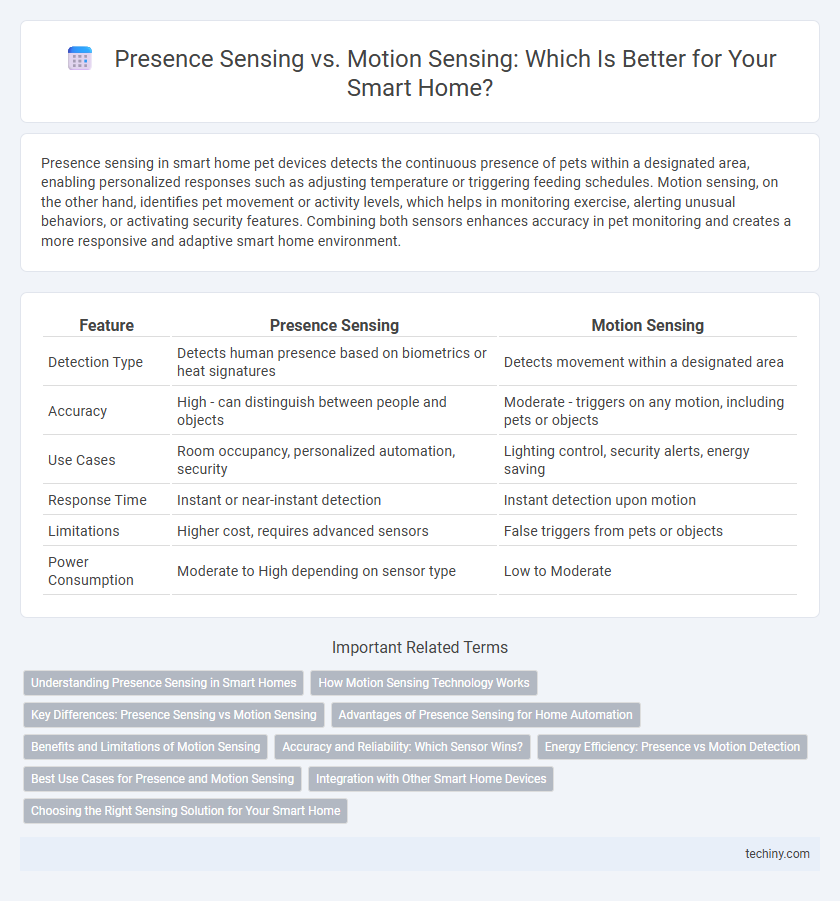Presence sensing in smart home pet devices detects the continuous presence of pets within a designated area, enabling personalized responses such as adjusting temperature or triggering feeding schedules. Motion sensing, on the other hand, identifies pet movement or activity levels, which helps in monitoring exercise, alerting unusual behaviors, or activating security features. Combining both sensors enhances accuracy in pet monitoring and creates a more responsive and adaptive smart home environment.
Table of Comparison
| Feature | Presence Sensing | Motion Sensing |
|---|---|---|
| Detection Type | Detects human presence based on biometrics or heat signatures | Detects movement within a designated area |
| Accuracy | High - can distinguish between people and objects | Moderate - triggers on any motion, including pets or objects |
| Use Cases | Room occupancy, personalized automation, security | Lighting control, security alerts, energy saving |
| Response Time | Instant or near-instant detection | Instant detection upon motion |
| Limitations | Higher cost, requires advanced sensors | False triggers from pets or objects |
| Power Consumption | Moderate to High depending on sensor type | Low to Moderate |
Understanding Presence Sensing in Smart Homes
Presence sensing in smart homes uses advanced technologies like infrared, ultrasonic waves, and cameras to detect whether an individual is stationary or moving, offering more accurate occupancy data than traditional motion sensors. Unlike motion sensing, which only registers movement, presence sensing can recognize when a room is occupied even without active motion, enhancing energy efficiency and personalized automation. Integrating presence sensing with smart lighting, HVAC systems, and security improves comfort by adapting settings based on actual occupancy patterns.
How Motion Sensing Technology Works
Motion sensing technology in smart homes relies on infrared sensors that detect changes in heat signatures caused by movement, enabling real-time activation of devices such as lighting and security systems. These sensors often use passive infrared (PIR) technology to monitor variations in infrared radiation emitted by humans or pets. By processing fluctuations in temperature within a defined area, motion sensors trigger automated responses without requiring manual input.
Key Differences: Presence Sensing vs Motion Sensing
Presence sensing detects human occupancy using sensors like infrared or ultrasonic to identify stationary or subtle movements, while motion sensing primarily detects larger, noticeable movements. Presence sensing enhances energy efficiency by maintaining lighting or HVAC based on actual occupancy, whereas motion sensing triggers devices only during active movement. The key difference lies in presence sensing's ability to monitor continuous occupancy versus motion sensing's reliance on movement detection for activation.
Advantages of Presence Sensing for Home Automation
Presence sensing in smart homes offers enhanced accuracy by detecting human presence through biometrics or thermal signatures, reducing false triggers common in motion sensing. This technology enables proactive automation, such as adjusting lighting and temperature based on actual occupancy, improving energy efficiency and comfort. Presence sensing supports personalized experiences by recognizing individual users, facilitating tailored environmental controls that motion sensors cannot achieve.
Benefits and Limitations of Motion Sensing
Motion sensing in smart homes offers real-time detection of movement, enabling automated lighting, security alerts, and energy savings by activating devices only when rooms are occupied. However, motion sensors may struggle with accuracy, sometimes failing to detect slow or minimal movements and triggering false alarms from pets or environmental factors. Integration with other sensors improves reliability, yet dependence on motion alone can limit context awareness compared to presence sensing technologies that detect occupancy more precisely.
Accuracy and Reliability: Which Sensor Wins?
Presence sensing uses infrared or ultrasonic waves to detect stationary occupants, offering higher accuracy in identifying actual room occupancy compared to motion sensing, which relies on detecting movement and can miss still individuals. Motion sensors often trigger false negatives during inactivity, reducing reliability in maintaining comfort or security settings. Overall, presence sensors provide more consistent and precise detection for smart home automation, enhancing energy efficiency and occupant convenience.
Energy Efficiency: Presence vs Motion Detection
Presence sensing offers superior energy efficiency by detecting human occupancy through body heat and micro-movements, enabling precise control of lighting and HVAC systems only when a person is actually present. In contrast, motion sensing relies on detecting larger movements and often results in premature deactivation or unnecessary energy use during periods of inactivity within an occupied space. Implementing presence detection technology reduces energy waste by maintaining system operation solely during true occupancy, optimizing power consumption in smart home environments.
Best Use Cases for Presence and Motion Sensing
Presence sensing excels in smart homes by accurately detecting whether a person is stationary or actively using a space, making it ideal for automating lighting and HVAC systems in living rooms and bedrooms to enhance comfort and energy efficiency. Motion sensing effectively triggers actions based on movement, proving best for security systems, hallway lighting, and areas requiring quick response to activity. Combining both sensors provides a comprehensive smart home experience, balancing energy savings with security and convenience.
Integration with Other Smart Home Devices
Presence sensing offers precise detection by identifying human occupancy through technologies like radar or infrared, enabling seamless integration with smart thermostats and lighting systems for energy-efficient climate control and automated ambiance adjustments. Motion sensing, relying on detecting movement with passive infrared sensors, effectively triggers security alarms and smart cameras but may lack the nuanced data needed for adaptive device management. Combining presence sensing with motion sensors enhances smart home ecosystems by delivering accurate occupancy data to optimize HVAC, lighting, and security device coordination.
Choosing the Right Sensing Solution for Your Smart Home
Presence sensing in smart homes detects human occupancy by monitoring body heat and micro-movements, offering precise automation for lighting and security. Motion sensing relies on detecting movement within a defined area, ideal for triggering actions like turning lights on or off when someone enters or leaves a room. Choosing the right solution depends on factors such as accuracy needs, installation environment, and desired automation complexity to enhance convenience and energy efficiency.
Presence Sensing vs Motion Sensing Infographic

 techiny.com
techiny.com